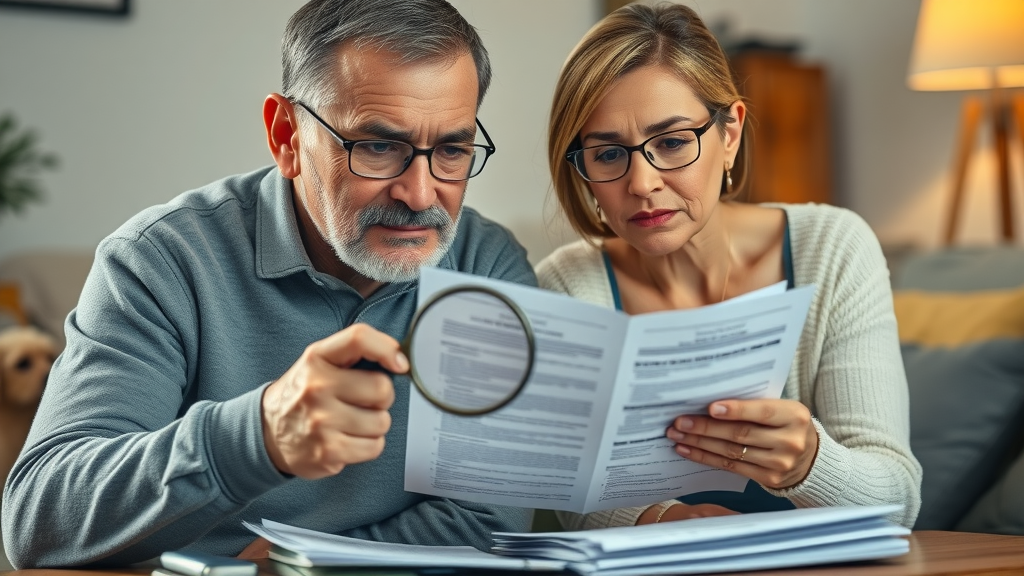Did you know that over 60% of American homes are underinsured ? Failing to review your home insurance policy or misunderstanding what your coverage actually includes could leave you facing overwhelming financial losses. Don’t wait until disaster strikes—knowing the most common home insurance mistakes and taking strategic action might be the difference between utter devastation and a safe recovery.
Why Overlooking Home Insurance Can Lead to Costly Mistakes
- 60% of American homes are underinsured, risking devastating out-of-pocket costs after disasters.
- Most policyholders misunderstand their home insurance coverage, leaving them financially vulnerable.
For millions of families, home insurance is the main safeguard against events like fires, floods, windstorms, or theft. Yet, many homeowners make the costly mistake of neglecting their policies—often until it is far too late. Without updating your coverage as your needs and property values change, you could find yourself shouldering massive out-of-pocket expenses.
Understanding and periodically reviewing your insurance policy is crucial. Ignoring important details can result in coverage gaps, which become painfully obvious when you file a claim and discover it’s either denied or insufficient for your losses. Think of homeowners insurance as your ultimate risk management tool—it should evolve as your home and lifestyle change.

Key Insights You’ll Gain On Home Insurance and How to Protect Your Home
- Understand common home insurance mistakes and how to avoid them.
- Learn about essential homeowners insurance terms and coverage options.
- Discover how to ensure your insurance policy covers all major risks.
In this comprehensive guide, you’ll discover the costly errors to avoid when managing your home insurance . We’ll break down policy language, explain the significance of replacement cost versus actual cash value, and show you how to shield your finances from devastating events. We’ll also address must-have options for personal property and liability coverage , ensuring you know how to protect your home from major risks.
By learning the ins and outs of homeowners insurance policies, you can make informed decisions, compare options, and avoid the traps that cost so many homeowners dearly. Whether you’re new to homeownership or seeking a policy tune-up, these lessons will help you sleep soundly, knowing your largest asset is genuinely protected.
Understanding Home Insurance: Essential Concepts Every Homeowner Should Know
What Is Home Insurance?
Home insurance , also known as homeowners insurance, is a financial product designed to shield you from losses associated with unforeseen damage to your home and belongings. It covers scenarios like fire, theft, vandalism, and even some natural disasters, offering peace of mind in a world full of uncertainties. If the worst happens, your policy can step in to cover repairs or replacement costs, ensuring stability after a covered loss.
While it’s common to see home insurance as just another bill, the truth is that this policy can mean survival after catastrophic property damage. Understanding your insurance coverage and speaking regularly with your insurance agent can help you spot any gaps. Remember: standard policies do not cover all hazards (e.g., you usually need separate flood insurance ), so staying informed is critical.

The Role of Homeowners Insurance in Protecting Your Home
Your homeowners policy is designed to protect your home and your finances. At its core, it offers protection from a variety of hazards, including property damage from storms, fire, or theft. However, its true value is in helping you rebound after disaster—by covering repair or rebuild costs, it can prevent a total financial collapse and help your family stay afloat during a crisis.
Besides safeguarding the building structure, homeowners insurance usually covers personal property inside the home, like furniture, electronics, and clothing. Policies also shield you from certain liabilities that arise if someone is injured on your property or if you unintentionally cause damage to another person’s property. Understanding the types of coverage can help you choose the right options for your needs, so you aren’t left unprotected or overpaying for unnecessary add-ons.
Types of Coverage in a Homeowners Insurance Policy
- Personal property
- Property damage
- Personal liability
- Additional coverage options
The most common types of coverage in a homeowners insurance policy include: protection for your physical home ( property damage ), your belongings ( personal property ), personal liability, and additional protections (like living expenses if your home becomes uninhabitable). Each portion of your policy covers a different risk, making it essential to review your policy annually and ensure you have adequate protection in every category.
Beyond the core components, additional coverage options can be tailored to your lifestyle—such as special riders for jewelry, fine art, or home business equipment. When you buy home insurance, don’t be tempted by the cheapest option. Instead, focus on selecting a policy that offers full protection, aligns with your home’s current value, and covers unique personal needs.
Underinsuring Your Property: The Hidden Dangers in Homeowners Insurance

Why Is Replacement Cost Critical in Home Insurance?
A critical but often misunderstood element of home insurance is the replacement cost —the amount it would take to rebuild your home as it was before major property damage . Many homeowners mistakenly insure their property for its market value, which can be significantly less than the replacement cost . After a disaster, this mistake could leave you with huge unreimbursed bills or even make it impossible to fully rebuild your home.
It’s vital to update your insurance policy as your home’s value increases due to renovations or regional construction cost changes. Coverage based on outdated figures or actual cash value (factoring in depreciation) may significantly shortchange you when you need it most. Always ensure your policy cover matches the real cost to rebuild your home today—not what you paid for it years ago.
Common Misconceptions About Insurance Coverage and Personal Property
Many policyholders believe their home insurance covers all expenses related to property damage, but there are often limits, sub-limits, or exclusions. For example, some coverage tiers impose caps on certain item categories or exclude specific loss events (like flood insurance ). This leaves many homeowners blindsided by major gaps in their insurance coverage after a claim.
“Many homeowners mistakenly assume their insurance policy covers the total rebuild cost of their home without verifying their policy limits.” – Insurance Expert
insurance policy insurance agent
Not Understanding Your Insurance Policy: A Costly Oversight
Reading the Fine Print: Key Terms in Your Home Insurance Policy
Your insurance policy document is often lengthy and filled with complex language. However, reading the fine print — and understanding essential terms — is how you protect your investment. Terms such as “covered loss,” “dwelling coverage,” “deductible,” and “policy exclusions” significantly affect whether and how much you’ll be reimbursed in the event of property damage .

Each homeowners policy spells out what is and isn’t covered, often in legal detail. If you don’t fully understand this language, you risk missing important weaknesses in your insurance cover . Take the time to ask your insurance agent to walk you through the document, and don’t hesitate to quiz them about confusing points and fine print that might cost you later.
Pitfalls of Ignoring Policy Exclusions and Policy Cover Limits
Every home insurance policy contains critical exclusions — types of property damage that simply are not covered. These can include flood or earthquake damage, routine wear and tear, mold caused by neglect, or even certain high-value personal items above your personal property sub-limits. Ignoring these gaps can set you up for disappointment and severe financial risk.
It’s equally important to understand policy limits for various insurance cover categories. If you suffer a covered loss but the damages exceed your maximum, you’ll be left paying the difference. Review your policy cover annually and especially after major life events (such as renovations, new valuables, or family changes). Proactive policy management can keep you protected and prevent disaster when you need help most.
Insurance Policy Coverage Table: Key Components to Know
| Coverage Type | What It Protects | Common Limits |
|---|---|---|
| Personal Property | Belongings | Varies |
| Property Damage | Building Structure | Full or Partial Value |
| Personal Liability | Legal/Medical | $100,000-$500,000 |
| Additional Coverage | Special risks | Optional |
Use this table to audit your own homeowners insurance policy . Identify where you need to upgrade insurance coverage or add extra options for your lifestyle. The right blend of standard and additional coverage creates robust security for your home and finances.
Homeowners Insurance and Liability Coverage: Avoiding Major Mistakes
Assessing Your Personal Liability and Living Expenses Coverage
Personal liability coverage protects you if someone is injured on your property or if you cause property damage, covering legal fees and medical costs. Many homeowners stick with the default liability coverage, which can be alarmingly insufficient if a major accident or lawsuit occurs. Review your policy to see if your liability protection matches your true risk exposure—especially if you have children, pets, or a pool.
Don’t overlook living expense benefits, often called “loss of use” or “additional living expenses.” If your home becomes uninhabitable due to a covered loss , this coverage kicks in to pay for hotels, meals, and extra transportation until your home is restored. Failing to maintain adequate living expenses coverage can mean paying thousands out of pocket during an already stressful period.
When to Consider Additional Coverage and Riders for Full Protection
Many homeowners benefit by expanding their home insurance with policy riders . These optional add-ons cover items that the standard home policy might not protect—think expensive jewelry, art pieces, special electronics, or outdoor features like sheds and fences. Some riders also address identity theft or home office operations.
When to consider:
- Review annual policy cover and adjust for renovations or additions.
- Add specialty riders for high-value personal property.
- Increase liability coverage if needed.
Misjudging the Value of Personal Property: An Expensive Error
How to Conduct a Personal Property Inventory for Accurate Home Insurance

To make sure your personal property is fully covered, start with a thorough home inventory. Document everything of value: take photos, record serial/model numbers, and keep receipts when possible. This will help your insurance company assess correct reimbursement in the event of property damage or theft.
Technology simplifies inventory tracking—apps let you upload images, categorize items, and update values over time. Make periodic updates and store a copy of your inventory securely off-site or in the cloud. This simple step can make the claims process faster and more reliable, reducing the risk of claim denials or undervaluing your belongings.
Commonly Overlooked Items in a Homeowners Insurance Policy

Many homeowners insurance policies limit coverage for things like cash, collectibles, jewelry, antiques, fine art, collectibles, and valuable electronics. Failing to list these items or add extra coverage leaves gaps, so be proactive: note every high-value object and check if a rider is required.
Don’t forget about non-traditional valuables, including home office equipment or unique furnishings. If you only report the value of your home’s structure and basic contents, you might severely underinsure your actual living situation, leaving your home and personal belongings at unnecessary risk.
Buying the Wrong Home Insurance Policy: Top Mistakes and What to Avoid
Comparing Homeowners Insurance: Price vs. Coverage

Comparing prices when you buy home insurance is natural, but chasing the lowest rate often means sacrificing adequate insurance cover . Some “cheap” policies offer minimal protection, high deductibles, or excessive limits and exclusions. Ultimately, a bargain policy might expose you to massive risks and unexpected expenses.
Balance affordability with coverage quality. Examine both the scope of protection and the policy covers for high-value items, liability, and living expenses. An experienced insurance agent or broker can explain the trade-offs and help you choose a policy tailored to your real needs, not just your wallet.
Questions to Ask Before You Buy Home Insurance
Don’t settle for the first quote—be proactive and ask your insurance company or agent essential questions:
- What perils or types of property damage are excluded?
- What is my replacement cost limit, and is it enough to completely rebuild your home ?
- Does my home insurance policy cover living expenses if my home is uninhabitable?
- Do I need additional coverage for home business equipment or collections?
- How often should I update my homeowners insurance to reflect home improvements?
This checklist can help you make informed decisions and avoid oversights that lead to expensive surprises down the road.
Overlooking Living Expenses in Your Home Insurance Coverage
Why Living Expenses Matter After Major Property Damage

Living expense (or loss of use) coverage in your homeowners policy pays for the cost of living elsewhere if your home becomes uninhabitable due to a covered loss . This may include hotel stays, apartment rentals, increased transportation, and even restaurant bills. Without this essential benefit, you could face overwhelming costs on top of property repairs.
The aftermath of disasters—like fires, floods, or severe storm property damage —can leave your family displaced for weeks or even months. Double-check how much your policy allocates for living expenses . Increase the limits if necessary to ensure your comfort and security should you ever need it.
Watch this expert video for insights from top insurance agents on reviewing, optimizing, and updating yourhome insurancepolicies. Get actionable strategies to maximize your protection, avoid costly mistakes, and ensure your policy coverage fits your unique home and personal circumstances.
People Also Ask: How much should home insurance cost?
Typical Home Insurance Costs and What Influences Your Premium
The average home insurance policy in the United States costs between $1,200 and $2,000 per year, but your premium can vary widely based on your location, home value, construction, and coverage choices. Upgrades, security features, and even your credit score can influence rates. Always compare quotes and shop around to make sure you’re getting the best value relative to the policy cover , not just the lowest sticker price.
Remember, the cheapest policy may not provide adequate insurance cover for your unique needs. Check your deductible, coverage limits, and any additional coverage options before deciding on a plan. Consult with your insurance agent to determine the best balance of cost and comprehensive protection to protect your home .
People Also Ask: Who is the cheapest homeowners insurance?
Finding Low-Cost Homeowners Insurance Without Sacrificing Coverage
The cheapest homeowners insurance isn’t always the best—companies like State Farm, Allstate, Progressive, and regional carriers may offer budget-friendly rates, but be wary of reduced coverage or high deductibles. Read reviews, evaluate the reputation of the insurance company, and consider the details of each insurance policy before buying.
To strike a balance, bundle your insurance policies (like auto and home), improve home security, increase your deductible, and ask about qualifying discounts. Always ensure that the insurance cover you receive still meets your requirements for rebuilding and replacing personal property after a disaster.
People Also Ask: What is the 80% rule in homeowners insurance?
Understanding the 80% Rule and How It Impacts Your Claim
The “80% rule” means your homeowners insurance policy requires you to insure your home for at least 80% of its full replacement cost to receive full payouts for covered loss . If you underinsure—say you cover only 60%—your insurer will reduce your claim payout proportionally. For example, if you insure a $250,000 home for only $200,000, in the event of property damage , you’ll recoup only part of your expenses.
Review your home’s replacement value with your insurance agent at least annually or after significant renovations. Staying above the 80% threshold ensures your insurance company will honor the full coverage terms and pay out what you need to rebuild your home and protect your assets.
People Also Ask: What are the three types of homeowners insurance?
Overview of Main Types of Homeowners Insurance Policies
The three most common types of homeowners insurance policies are:
- HO-1 (Basic Form): The simplest, covering only a narrow set of perils and offering minimal insurance coverage .
- HO-2 (Broad Form): Standard home policies that provide broader policy cover for additional perils; costs more but offers more peace of mind.
- HO-3 (Special Form): The most popular choice, covering the home’s structure against “all perils” except those specifically excluded. Personal property is generally covered for named perils only.
Your insurance agent can explain which type of policy and coverage level aligns best with your property, location, and risk tolerance. Periodically review your homeowners policy to ensure that it still fits your evolving needs.
Watch actual homeowners recount real-life insurance claim stories—how costly mistakes led to gaps in coverage, unexpected expenses, and financial hardship. Learn their lessons and act now to avoid repeating these avoidable errors.
Frequently Asked Questions about Home Insurance Mistakes
- How often should I update my home insurance policy?
Review your home insurance policy at least once a year, or after any major home renovation, purchase of valuables, or lifestyle change. This keeps your coverage current and effective. - What does a homeowners insurance policy typically not cover?
Most policies do not cover floods, earthquakes, routine wear and tear, or high-value personal items above certain limits unless you add special riders. Always clarify exclusions with your insurance agent . - How do I file a claim for personal property damage?
Contact your insurance company promptly, document all damaged or lost items, complete claim forms, and provide proof through receipts, photos, and serial numbers for fast and accurate processing.
Critical Takeaways for Protecting Your Home and Finances with Home Insurance
- Regularly review your homeowners insurance policy for full coverage.
- Assess the value of your property and possessions accurately.
- Make informed choices between cost and comprehensive insurance coverage.
Secure Your Home: Get a Comprehensive Home Insurance Review Today
Don’t wait for disaster to test your coverage—schedule a detailed home insurance review today. Protect your property, assets, and peace of mind for years to come.
Sources
- https://www.iii.org/article/what-homeowners-insurance-policy-covers – III: Insurance Information Institute
- https://www.naic.org/consumer_homeowners.htm – National Association of Insurance Commissioners
- https://www.fema.gov/flood-insurance – FEMA Flood Insurance
- https://www.consumerreports.org/homeowners-insurance/how-to-avoid-homeowners-insurance-surprises/ – Consumer Reports
- https://www.nerdwallet.com/article/insurance/homeowners-insurance-mistakes – NerdWallet
To deepen your understanding of common home insurance mistakes and how to avoid them, consider exploring the following resources:
-
“Avoid These 5 Common Homeowners Insurance Mistakes” : This article highlights critical errors such as neglecting to include “other structures” in your policy and failing to account for inflation protection, providing actionable advice to ensure comprehensive coverage. ( libertymutual.com )
-
“9 Homeowners Insurance Mistakes to Avoid” : This resource outlines pitfalls like not understanding policy exclusions and setting inappropriate deductibles, offering strategies to optimize your insurance policy effectively. ( experian.com )
By reviewing these articles, you can gain valuable insights into safeguarding your home and finances against potential insurance oversights.


